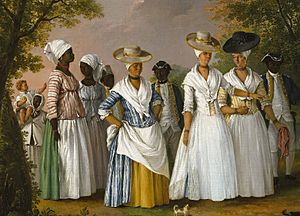Free people of color facts for kids

Free people of color were a special group of people in the history of the Americas. They lived during a time when many people were enslaved. But these individuals were not enslaved. They were free.
Most free people of color had a mix of backgrounds. Their families often came from Africa, Europe, and sometimes Native American groups. They were known by different names. In French, they were called gens de couleur libres. In Spanish, they were called gente de color libre.
This group was very important in French colonies. These included places like Louisiana (New France). They also lived on Caribbean islands. Some of these islands were Saint-Domingue (now Haiti), St. Lucia, Dominica, Guadeloupe, and Martinique.
In these areas, especially in cities like New Orleans, a new social group formed. This group was made up mostly of mixed-race people who were free. They were seen as a separate class. They were different from both enslaved people and fully European settlers.
In the Thirteen Colonies (which later became the United States), a similar term was used. People called them "free negroes". This term described people who were legally free. They also had visible African heritage. Many of these free people were of mixed race. Sometimes, they gained their freedom because of family ties to their enslavers or other white people.
Images for kids
-
A free woman of color with her daughter. This painting is from New Orleans in the late 1700s.
See also
 In Spanish: Persona de color libre para niños
In Spanish: Persona de color libre para niños



